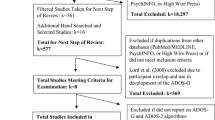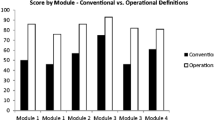Abstract
The ADOS-2 is a gold-standard assessment used to diagnose autism spectrum disorders. In this chapter, we describe the design, scoring, and history of this measure as well as some of its clinical and research applications. The ADOS-2 is widely used and is appropriate for individuals across the lifespan, from children as young as 12 months through adulthood. A unique Comparison Score is available. With it, autism severity can be compared among individuals, or an individual’s symptom severity can be tracked over time. Of particular importance is the inclusion of a Toddler Module that allows for the diagnosis of children under the age of three, providing the opportunity for intervention to begin at an early age. The ADOS is used widely in autism research and is a valuable tool to differentiate groups of children.
Access this chapter
Tax calculation will be finalised at checkout
Purchases are for personal use only
Similar content being viewed by others
References
Dawson G. Early behavioral intervention, brain plasticity, and the prevention of autism spectrum disorder. Dev Psychopathol. 2008;20:775–803.
De Bildt A, Sytema S, van Lang N, et al. Evaluation of the ADOS revised algorithm: the applicability in 558 Dutch children and adolescents. J Autism Dev Disord. 2009;39:1350–8.
Dissanayake C, Bui Q, Bulhak-Paterson D, Huggins R, Loesch D. Behavioural and cognitive phenotypes in idiopathic autism versus autism associated with fragile X syndrome. J Child Psychol Psychiatry. 2009;50:290–9.
Gotham K, Risi S, Pickles A, Lord C. The autism diagnostic observation schedule: revised algorithms for improved diagnostic validity. J Autism Dev Disord. 2007;37:613–27.
Gotham K, Pickles A, Lord C. Standardizing ADOS scores for a measure of severity in autism spectrum disorders. J Autism Dev Disord. 2009;39:693–705.
Kasari C, Paparella T, Freeman S, Jahromi L. Language outcome in autism: randomized comparison of joint attention and play interventions. J Consult Clin Psychol. 2008;76:125–37.
Le Couteur A, Haden G, Hammal D, McConachie H. Diagnosing autism spectrum disorders in pre-school children using Two standardised assessment instruments: the ADI-R and the ADOS. J Autism Dev Disord. 2008;38:362–72.
Lord C, Risi S, Lambrecht L, et al. The autism diagnostic observation schedule–generic: a standard measure of social and communication deficits associated with the spectrum of autism. J Autism Dev Disord. 2000;30:205–23.
Lord C, Rutter M, DiLavore PC, et al. Autism diagnostic observation schedule, second edition: ADOS-2. Torrance: Western Psychological Services; 2012.
Luyster R, Gotham K, Guthrie W, et al. The autism diagnostic observation schedule – toddler module: a new module of a standardized diagnostic measure for autism spectrum disorders. J Autism Dev Disord. 2009;39:1305–20.
Mosconi M, Hazlett H, Poe M, et al. Longitudinal study of amygdala volume and joint attention in 2-to 4-year-old children with autism. Arch Gen Psychiatry. 2009;66:509–16.
Oosterling I, Roos S, de Bildt A, et al. Improved diagnostic validity of the ADOS revised algorithms: a replication study in an independent sample. J Autism Dev Disord. 2010;40:689–703.
Rutter M, Le Couteur A, Lord C. Autism diagnostic interview-revised–WPS. WPS ed. Los Angeles: Western Psychological Services; 2003.
Wallace K, Rogers S. Intervening in infancy: implications for autism spectrum disorders. J Child Psychol Psychiatry. 2010;51:1300–20.
Western Psychological Services (WPS). Autism diagnostic observation schedule, second edition: ADOS-2. http://portal.wpspublish.com. Viewed May 2012.
Author information
Authors and Affiliations
Corresponding author
Editor information
Editors and Affiliations
Rights and permissions
Copyright information
© 2014 Springer Science+Business Media New York
About this entry
Cite this entry
Hurwitz, S., Yirmiya, N. (2014). Autism Diagnostic Observation Schedule (ADOS) and Its Uses in Research and Practice. In: Patel, V., Preedy, V., Martin, C. (eds) Comprehensive Guide to Autism. Springer, New York, NY. https://doi.org/10.1007/978-1-4614-4788-7_16
Download citation
DOI: https://doi.org/10.1007/978-1-4614-4788-7_16
Publisher Name: Springer, New York, NY
Print ISBN: 978-1-4614-4787-0
Online ISBN: 978-1-4614-4788-7
eBook Packages: Behavioral Science




